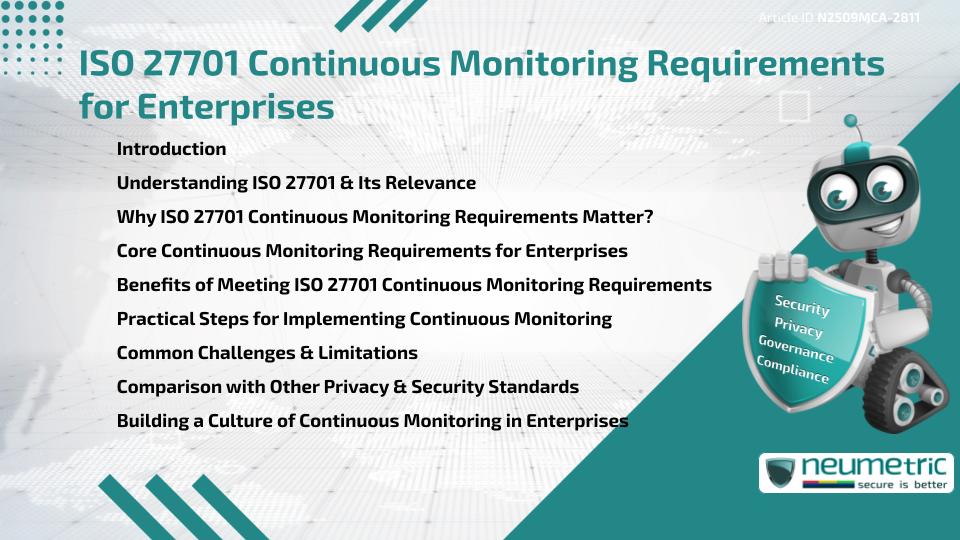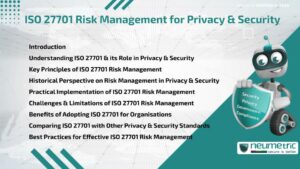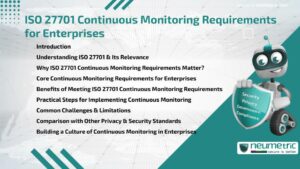Table of Contents
ToggleIntroduction
The ISO 27701 Continuous Monitoring requirements are essential for enterprises managing Personal Data in compliance with international Privacy Standards. ISO 27701, an extension of ISO 27001 & ISO 27002, provides a Framework for implementing a Privacy Information Management System [PIMS]. Continuous Monitoring under this Framework ensures that enterprises can identify, respond & adapt to evolving Privacy Risks. By embedding ISO 27701 Continuous Monitoring requirements, Organisations demonstrate accountability, reduce compliance Risks & foster trust with Stakeholders.
Understanding ISO 27701 & Its Relevance
ISO 27701 expands upon the widely adopted ISO 27001 Information Security standard, with a focus on Data Privacy management. It addresses how Organisations handle Personally Identifiable Information [PII] and establishes guidelines for both data controllers & processors. Continuous Monitoring ensures that enterprises remain compliant over time rather than relying solely on one-off audits or periodic reviews.
This relevance is particularly critical as regulatory expectations, such as the General Data Protection Regulation [GDPR] and the California Consumer Privacy Act [CCPA], demand ongoing vigilance.
Why ISO 27701 Continuous Monitoring Requirements Matter?
Continuous Monitoring ensures enterprises do not treat Privacy as a static compliance exercise but as an ongoing responsibility. By meeting ISO 27701 Continuous Monitoring requirements, enterprises can:
- Detect & address Privacy Risks in real time
- Maintain alignment with evolving regulatory obligations
- Demonstrate accountability to Customers & partners
- Strengthen resilience against breaches or data misuse
Without Continuous Monitoring, even the most well-documented PIMS may become outdated or ineffective in practice.
Core Continuous Monitoring Requirements for Enterprises
Key requirements under ISO 27701 for Continuous Monitoring include:
- Ongoing Risk Assessments – Regularly evaluating Threats to PII.
- Policy & Control Reviews – Ensuring Policies & safeguards remain up-to-date.
- Incident Detection & Response – Maintaining systems for early identification of Privacy breaches.
- Third Party Oversight – Monitoring vendors & partners that process PII.
- Audit Trails & Documentation – Recording compliance activities for Transparency & Accountability.
- Employee Training & Awareness – Keeping staff informed about evolving Risks & responsibilities.
These requirements ensure enterprises sustain compliance beyond certification.
Benefits of Meeting ISO 27701 Continuous Monitoring Requirements
Enterprises benefit in several ways:
- Improved Regulatory Compliance across multiple jurisdictions
- Enhanced trust with Customers, regulators & partners
- Better Risk Management through proactive detection & response
- Increased operational efficiency by streamlining monitoring processes
- Stronger corporate reputation as a responsible steward of Personal Data
These benefits collectively reinforce Governance & market positioning.
Practical Steps for Implementing Continuous Monitoring
Enterprises can follow these steps to embed Continuous Monitoring into operations:
- Define Monitoring Objectives – Align with organizational goals & regulatory obligations.
- Automate Monitoring Tools – Leverage technologies for log management, intrusion detection & compliance tracking.
- Conduct regular Audits – Perform internal reviews to validate effectiveness.
- Integrate Vendor Oversight – Extend monitoring to Third Party service providers.
- Establish Feedback Loops – Continuously improve controls based on findings.
These practical steps transform abstract requirements into operational practices.
Common Challenges & Limitations
Enterprises often encounter obstacles when implementing ISO 27701 Continuous Monitoring requirements. These include resource limitations, integration challenges with legacy systems & difficulty maintaining oversight of complex Vendor ecosystems. Additionally, Organisations may face internal resistance due to perceived increases in workload or costs. Overcoming these barriers requires leadership commitment, resource allocation & a culture that values accountability.
Comparison with Other Privacy & Security Standards
ISO 27701 shares common ground with other Standards but emphasizes Privacy-specific requirements. For instance:
- ISO 27001 focuses on general Information Security management.
- GDPR mandates accountability & ongoing compliance for Organisations handling EU residents’ data.
- SOC 2 centers on service provider controls but lacks the Privacy-specific detail found in ISO 27701.
By aligning with ISO 27701 Continuous Monitoring requirements, enterprises complement these Frameworks while gaining a Privacy-centric edge.
Building a Culture of Continuous Monitoring in Enterprises
Success depends on creating a culture where Continuous Monitoring becomes second nature. Enterprises can achieve this by embedding monitoring into daily workflows, incentivizing proactive Risk Management & making transparency a shared responsibility. When teams internalize these practices, monitoring evolves from a compliance task into a driver of resilience & trust.
Conclusion
The ISO 27701 Continuous Monitoring requirements provide enterprises with a Roadmap to strengthen Privacy Governance & operational resilience. By embedding these requirements into daily operations, Organisations not only maintain compliance but also demonstrate their role as trustworthy custodians of Personal Data.
Takeaways
- ISO 27701 extends ISO 27001 with Privacy-specific guidance.
- Continuous Monitoring ensures ongoing compliance & adaptability.
- Requirements include Risk Assessments, Vendor oversight & training.
- Benefits include stronger trust, efficiency & resilience.
- Building a culture of monitoring is key to long-term success.
FAQ
What are ISO 27701 Continuous Monitoring requirements?
They are the ongoing processes enterprises must implement to ensure compliance with Privacy obligations & maintain effective Data Protection.
Why is Continuous Monitoring important in ISO 27701?
It ensures that Privacy management systems remain effective & up-to-date in addressing evolving Risks & regulations.
What activities are included in Continuous Monitoring?
They include Risk Assessments, policy reviews, Incident Response, Vendor oversight & staff training.
How does ISO 27701 differ from ISO 27001?
ISO 27701 builds on ISO 27001 but focuses specifically on managing Personally Identifiable Information [PII] and Privacy Risks.
What challenges do enterprises face in Continuous Monitoring?
Common challenges include resource constraints, legacy system integration & complex Vendor ecosystems.
Can Continuous Monitoring improve Customer Trust?
Yes, it demonstrates accountability & proactive Data Protection, which enhances Customer & partner confidence.
Does ISO 27701 align with regulations like GDPR?
Yes, ISO 27701 complements GDPR & other Privacy regulations by offering a structured compliance Framework.
Need help for Security, Privacy, Governance & VAPT?
Neumetric provides organisations the necessary help to achieve their Cybersecurity, Compliance, Governance, Privacy, Certifications & Pentesting needs.
Organisations & Businesses, specifically those which provide SaaS & AI Solutions in the Fintech, BFSI & other regulated sectors, usually need a Cybersecurity Partner for meeting & maintaining the ongoing Security & Privacy needs & requirements of their Enterprise Clients & Privacy conscious Customers.
SOC 2, ISO 27001, ISO 42001, NIST, HIPAA, HECVAT, EU GDPR are some of the Frameworks that are served by Fusion – a SaaS, multimodular, multitenant, centralised, automated, Cybersecurity & Compliance Management system.
Neumetric also provides Expert Services for technical security which covers VAPT for Web Applications, APIs, iOS & Android Mobile Apps, Security Testing for AWS & other Cloud Environments & Cloud Infrastructure & other similar scopes.
Reach out to us by Email or filling out the Contact Form…





